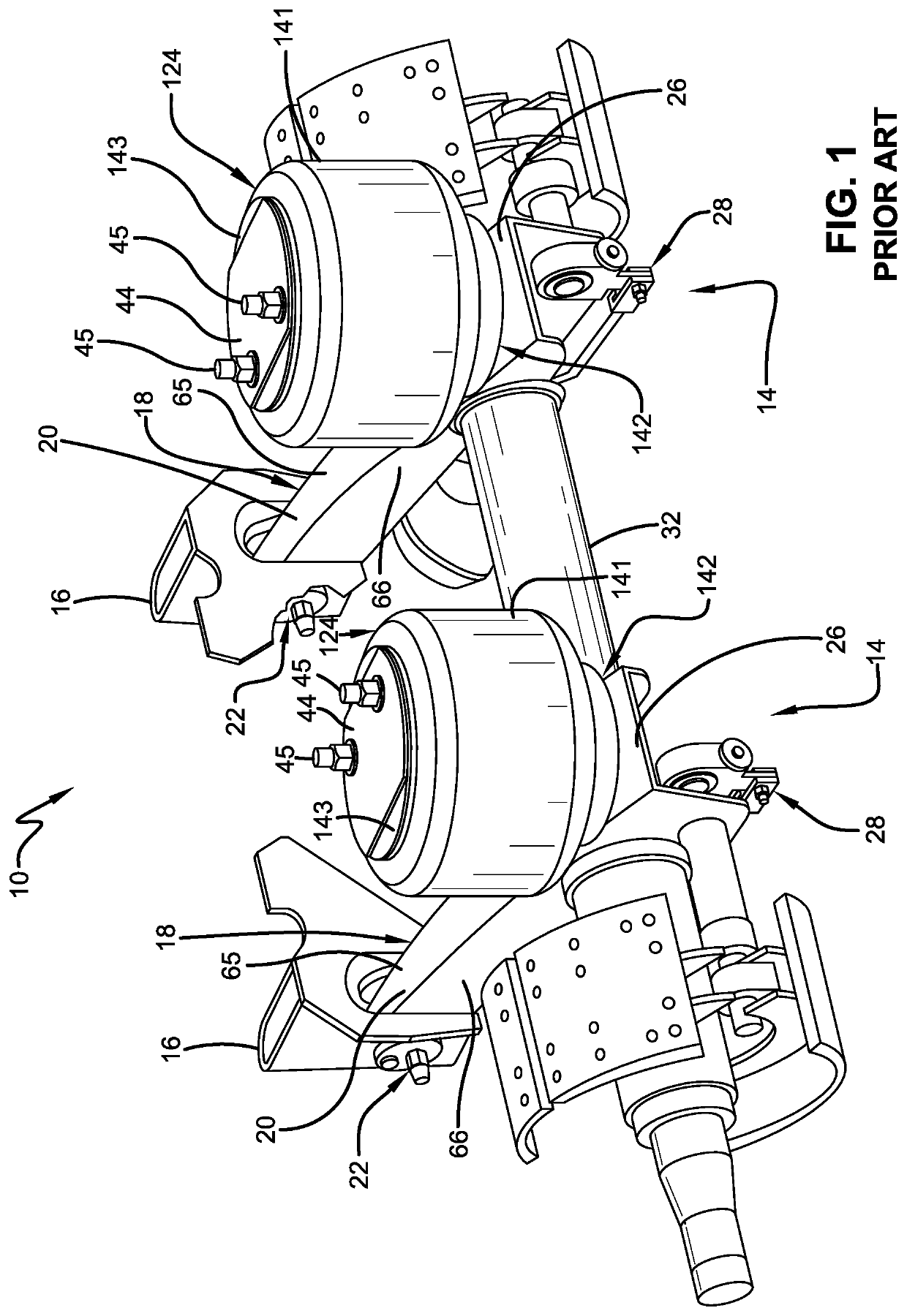At these frequencies, the axle / suspension
system is predisposed to move such that road inputs at these frequencies may result in a
harmonic build-up of movement in the axle / suspension
system that can potentially adversely affect the performance of the axle / suspension system.
Prior art air springs without damping characteristics, while adequately
cushioning the heavy-duty vehicle cargo and occupant(s) during operation, have potential disadvantages, drawbacks, and limitations.
For example, the manner in which prior art air springs secure the bellows to the piston may potentially result in the bellows becoming dislodged or separated from the piston during rebound events.
More specifically, during an extreme rebound event, the bellows may become over-extended such that the bottom portion of the bellows may become unsecured from the piston.
Prior art non-damping air springs also provide little, if any, damping characteristics to the axle / suspension system.
However, these shock absorbers experience changes and limitations in their damping performance.
In particular, shock absorbers typically experience changes in performance characteristics over time as they wear, causing changes in the ride and handling characteristics of the heavy-duty vehicle that, in turn, may cause additional wear of the tires and other components of the axle / suspension system over time.
More particularly, these changes can potentially increase
operational costs of the heavy-duty vehicle.
Thus, as
payload is added or removed from the heavy-duty vehicle, the performance of the shock absorbers may potentially become non-optimal.
More specifically, shock absorbers are typically designed for the heaviest expected
payload of the heavy-duty vehicle such that the axle / suspension system will become overdamped for lighter loads, potentially increasing wear on the tires and other components of the axle / suspension system.
Furthermore, shock absorbers are a service item of the axle / suspension system that require maintenance and / or replacement from time to time, resulting in increased maintenance and / or replacement costs of the axle / suspension system.
Shock absorbers also add varying degrees of complexity and weight to the axle / suspension system.
More particularly, because shock absorbers are relatively heavy, the shock absorbers add undesirable weight to the axle / suspension system, thereby reducing the amount of cargo that can be carried by the heavy-duty vehicle.
This pressure differential causes air to flow between the bellows and piston chamber through the opening(s) of the piston top plate causing damping to occur.
Prior art air springs with damping characteristics, while providing adequate damping to the axle / suspension system of the heavy-duty vehicle, have potential disadvantages, drawbacks, and limitations.
However, prior art damping air springs generally only provide peak damping characteristics for a single
critical frequency range.
In addition, the structure and attachment of the bellows of prior art damping air springs can potentially cause changes in the damping energy of the air spring during
jounce events or separation of the bellows from the piston during rebound events.
During a
jounce event or under increased load, compression of the prior art damping air spring bellows typically increases the tension on the bellows material, potentially causing the bellows material to stretch radially and the bellows
diameter to expand beyond a nominal
diameter, increasing the volume of the bellows chamber, thereby decreasing the damping energy of the prior art air spring.
In addition, during an extreme rebound event, the bellows may become over-extended, such that the bottom portion of the bellows may potentially become unsecured from the piston, potentially causing air loss and / or damage to the prior art air spring and / or other components of the axle / suspension system.
Furthermore, prior art damping air springs with intermediate chambers generally require separate manufacturing and
assembly of the intermediate chamber and air spring bellows.
The top plates of the intermediate chambers are generally large, and the support mechanisms are typically complex multi-component structures, increasing the weight, complexity, cost of materials and manufacturing, and difficulty of repair and / or replacement of the intermediate chamber.
However, the support mechanisms can potentially limit air flow within the piston chamber, obstruct air spring travel, cause damage to the piston, or require additional components.
Moreover, embedded support mechanisms for the intermediate chamber are difficult to optimize, potentially resulting in improper or non-optimal stiffness, restriction of air spring travel, or premature collapse of the intermediate chamber and loss of damping energy.
During jounce events, the bellows top plate may contact the top plate of the intermediate chamber, potentially obstructing the openings in the top plate of the intermediate chamber, thereby limiting or obstructing fluid flow between the bellows and intermediate chamber.
 Login to View More
Login to View More  Login to View More
Login to View More 


